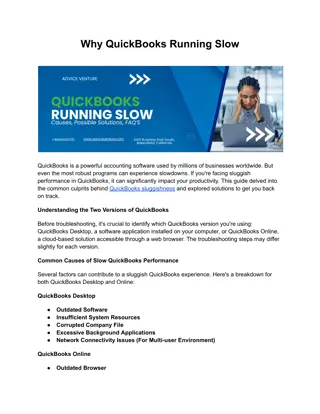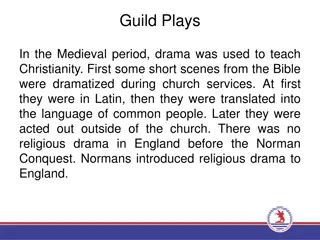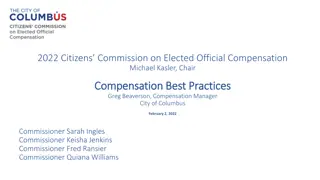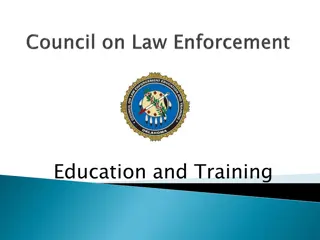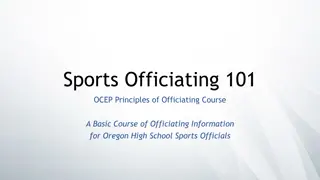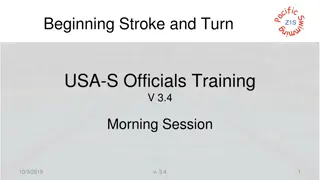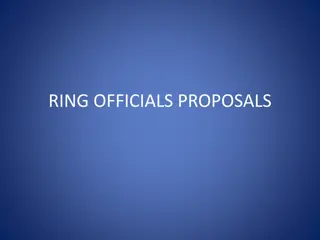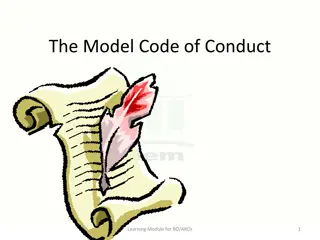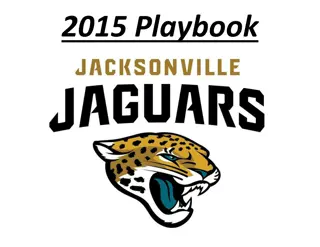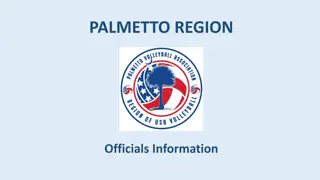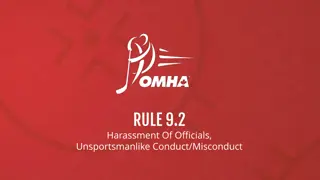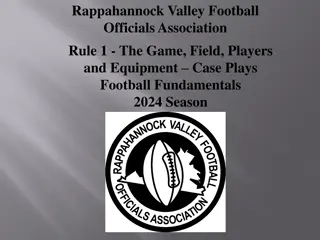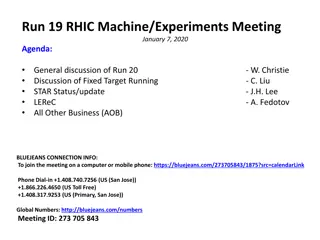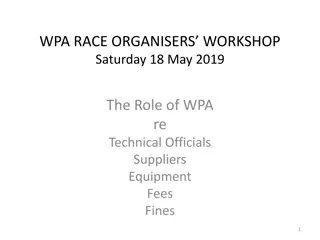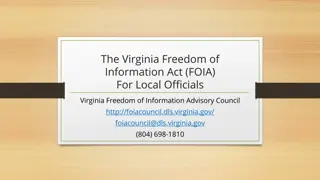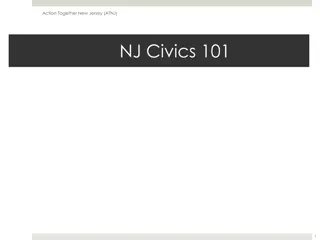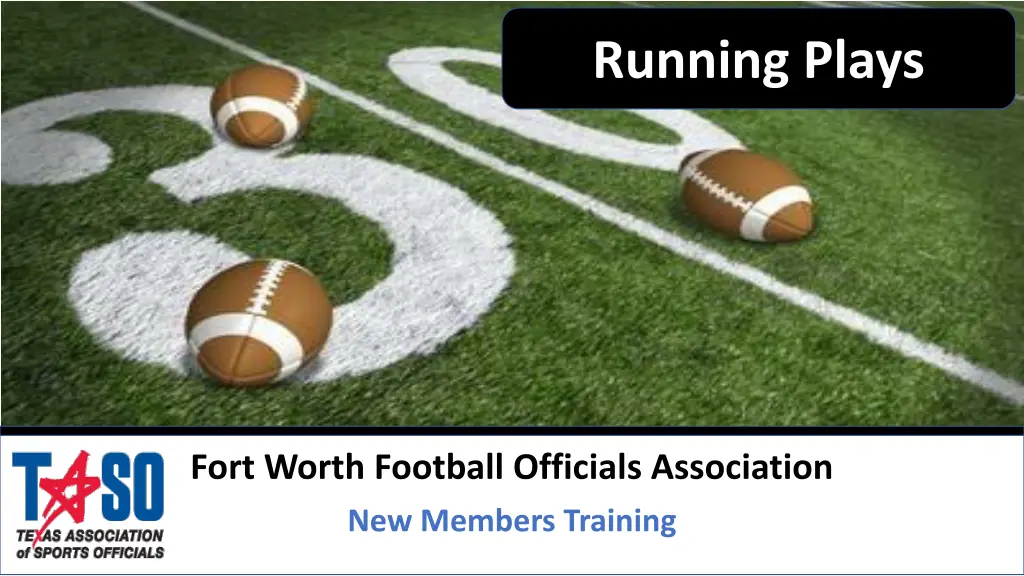
Fort Worth Football Officials Association New Members Training Sessions
Join the Fort Worth Football Officials Association for training sessions focused on understanding football rules. Learn about running plays, ready for play signals, lineman and backs positioning, and dead ball fouls. Gain insights into important aspects of football officiating to enhance your knowledge and skills. Disclaimer: Information provided is condensed, always refer to official rule books for final authority.
Download Presentation

Please find below an Image/Link to download the presentation.
The content on the website is provided AS IS for your information and personal use only. It may not be sold, licensed, or shared on other websites without obtaining consent from the author. If you encounter any issues during the download, it is possible that the publisher has removed the file from their server.
You are allowed to download the files provided on this website for personal or commercial use, subject to the condition that they are used lawfully. All files are the property of their respective owners.
The content on the website is provided AS IS for your information and personal use only. It may not be sold, licensed, or shared on other websites without obtaining consent from the author.
E N D
Presentation Transcript
Running Plays Fort Worth Football Officials Association New Members Training
Objective Objective The intent of this training session is to help you understand and familiarize you with the rules pertaining to Football. It s important you also read and study the NCAA Rules, UIL Exceptions and TASO mechanics manuals outside of training sessions to get the best understanding possible on football officiating. Disclaimer The information covered has been condensed and paraphrased to help you understand both the intent and the philosophy of the rules. The current NCAA Rule Book & UIL Exceptions are the final authority. 2 Running Plays
Ready For Play Ready For Play - - RECAP RECAP A dead ball is READY FOR PLAY when the referee With the 40-second play clock running, an official places the ball at a hash mark or between the inbounds marks and steps away to his position. With the play clock set at 25 seconds, or at 40 seconds after an injury to or loss of helmet by a defensive team player, the referee sounds his whistle and either signals to start the game clock [S2] or signals that the ball is ready for play [S1] - Do not signal both! Running Plays 3
Lineman & Backs Lineman & Backs - - RECAP RECAP BACK LINEMEN A BACK is any TEAM A player who is not a LINEMANand whose head or body doesn t break the plane of a line drawn through the waistline, of the nearest TEAM A LINEMAN. The player in position to receive a hand to hand snap. A lineman becomes a BACK before the snap when he moves to a position as a BACK and stops. For a TEAM A player to be considered on the line of scrimmage : They must be the snapper or Their head must break the plane of a line drawn through the waistline of the snapper. All LINEMENmust face their opponent s goal line. Their shoulders must be approximately parallel to the LOS. Interior Linemen: Not on the end of his scrimmage line. Restricted Linemen: Interior or numbered 50-79. There cannot be more than 4 BACKS in the backfield at the snap. Running Plays 4
Dead Ball Fouls Dead Ball Fouls Dead Ball Fouls: Foul that a team CANNOT correct. Throw Flag into the air and blow whistle to get the play shut down. Avoid further problems by reacting quickly. Dead Ball Fouls by TEAM A: Illegal Substitution Delay of Game Offensive Encroachment Illegal Snap False Start such as: - Simulating Start of Snap - Motion Man Turning up Early - Restricted Lineman picking up his hand - Lineman Shifting into a 3 or 4-point stance at the snap - All players not set for at least 1 second before snap Dead Ball Fouls by TEAM B: Defense Offside (w/ contact) Defense Offside (TEAM B player in NZ Causing TEAM A player to Respond) Defense Offside (Unabated to the QB) Unnatural movement trying to create a False Start on TEAM A Illegal Substitution 12 men in formation w/ snap imminent Running Plays 5
Live Ball Fouls Live Ball Fouls Live Ball Fouls: Fouls that do NOT occur until you have a SNAP. Teams can correct before the SNAP. Throw your Flag into the air and CONTINUE to OFFICIATE Live Ball Fouls by TEAM A: Illegal Formation Illegal Motion Illegal Shift Live Ball Fouls by TEAM B: Defense Offside (Lined up in the NZ) Running Plays 6
Pre Pre- -Snap Snap Basic Positions(3 Basic Positions(3- -Man Crew) Chain Crew LTG Down indicator Man Crew) R After making the ball ready for play, be in a position to see the ball and the backs, 11 to 15 yards behind the LOS. Initial position is near the center of the field. H H, L Be on or outside the sideline at LOS. Indicate offensive LOS by an extended foot to wide offensive players. R H Be opposite press box, on the LOS. Ensure chain crew is in position. ALL Check down & distance; verify clock status L Running Plays 7
After the Snap After the Snap - - Referee (3 Referee (3- -Man Crew) Man Crew) Referee (R) Observe initial charge of lineman for infractions by players of either team. Watch for illegal action by blockers leading the runner. Make sure all blocks and play are legal behind scrimmage line. Follow the runner to the sideline behind the line of scrimmage. Watch for fouls behind runner after he crosses neutral zone. If play goes away from you, trail behind and observe action behind runner and behind flank official. Be in position to cover runner if he returns into your area. Retrieve ball if runner s forward progress is stopped and driven back (H/L will hold forward progress spot) Once ball is dead and it is safe to do so retrieve it for placement at succeeding spot and ready for play don t stop dead ball officiating! H/L will place the ball at dead ball spot if in their side zone. If dead ball spot is close to line to gain make ruling if 1st down or not. Running Plays 8
After the Snap After the Snap H & L (3 H & L (3- -Man Crew) Man Crew) H, L Responsible for NZ infractions. Responsible for blockers and action on ends and linebackers. Be alert to cover forward progress of runner. Opposite side officials should assist with forward progress if the covering official is not in position to rule. If play goes away from you, observe action in offensive backfield behind runner and behind R. Be in position to cover runner if he returns into your area. Pinch in when necessary, especially on short yardage for first down and if possible on every play within 10-yard line and goal line. Be prepared to rule on forward progress. On plays into your side zone area and on wide offensive plays, be prepared to take runner and ball to goal line. R covers behind you. You are responsible for your sideline, end line to end line. Responsible for clipping and illegal blocks below the waist blocks (R can assist). For out of bounds plays on your sideline, hold spot, another official will retrieve ball. Clean up out of bounds. Do not get boxed in or turn your back to the ball. When ball becomes dead in your area, relay ball to R if possible. Watch for any illegal action around runner when the ball is declared dead by another official, then assist in spotting ball. If ball goes out of bounds, or clear that a 1st down is made, signal time out immediately. Assist R in starting game clock after awarding TEAM A first down if it is to be started. (Only R should signal) Running Plays 9
After the Play (3 After the Play (3- -Man Crew) Man Crew) H and L, do not jump over players as you mark progress with downfield out thrust foot (unobtrusively, not making a production of it). If necessary, come into the field ( pinch in ) as necessary. Hold spot with foot until you are sure R or other official has spot. R should go quickly to the approximate position of the dead ball spot, check the down and distance with the H and L and announce and indicate the new down. R is primarily responsible for lateral placement of the ball at the previous spot after an incomplete pass, penalty, etc. H and L should assist with relaying ball as much as possible. H - ensure chains & down-box are moved to correct position. Other officials should verify a well. If the play clock is to be started on R s signal, R should declare the ball ready for play by blowing his whistle and giving ready signal (or wind the clock). Under unusual circumstances this procedure may vary and require discretionary action by R. If the game clock should be started after TEAM A is awarded a first down, R will start the clock with a winding signal and soft whistle when the point of the new series of downs has been established by H. Running Plays 10
Common Live Ball Fouls Common Live Ball Fouls Holding Illegal Formation Offside Illegal Motion Illegal Shift Illegal block below the waist Illegal block in the back Face mask Illegal hands to the face Chop Block Horse Collar Tackle Running Plays 11
Holding Holding HOLDING Using the hand(s) and arm(s) to grasp, pull, hook, clamp or encircle in any way that illegally impedes or illegally obstructs an opponent. Holding Categories 1. Grab and Restrict 2. Hook and Restrict 3. Jerk and Restrict 4. Turn and Twist 5. Tackle 6. Take down Running Plays 12
Holding Holding (cont d) (cont d) Point of Attack. When they get beat THEY LL CHEAT! Make it HUGE! Running Plays 13
Helmet and Face Mask Fouls (9 Helmet and Face Mask Fouls (9- -1 1- -8, FR 8, FR- -90) 90) No player shall continuously contact an opponent s face, helmet (including the face mask) or neck with hand(s) or arm(s) (Exception: By or against the runner). No player shall grasp and then twist, turn or pull the face mask, chin strap or any helmet opening of an opponent. It is not a foul if the facemask, chin strap or helmet opening is not grasped and then twisted, turned or pulled. When in question, it is a foul. Running Plays 14
Horse Collar Tackle (9 Horse Collar Tackle (9- -1 1- -15, FR 15, FR- -91) 91) All players are prohibited from grabbing the inside back collar of the shoulder pads or jersey, the nameplate area, or the inside collar of the side of the shoulder pads or jersey, and immediately pulling the ball carrier down. This does not apply to a ball carrier, including a potential passer, who is inside the tackle box. (Note: the tackle box disintegrates when the ball leaves it) Running Plays 15
Common After the Play Dead Ball Fouls Common After the Play Dead Ball Fouls Late Hit Unsportsmanlike Conduct Personal Foul Unnecessary Roughness Running Plays 16
Fumble Fumble - - Mechanics Mechanics When an official actually sees a live ball fumbled they will DROP their bean bag to mark the approximate yard line where fumble occurred. NOT WHEN THEY SEE THE BALL LOOSE BUT ONLY IF THEY ACTUALLY SEE THE FUMBLE OCCUR! When recovered, the nearest official should point in the proper direction, no matter who recovers. R will then signal the next down when he makes the ball ready for play. Running Plays 17
Digging out Fumbles Digging out Fumbles DIGGING OUT FUMBLES Nearest official digs for the ball, Next official stops clock verifies. The stop the clock signal should be relayed rest of crew, 2nd official should assist removing players from the pile, 3rd official controls other players and watches for a player escaping from the pile with ball. When the digging official determines possession he should verbally relay possession information to the nearest standing official, normally the R, who will then signal the proper direction. If possible, the signaling official will point to the recovering player to assist the press box. Only the R, if he is not the signaling official, should relay the direction signal. Running Plays 18
Signals Signals DEAD BALL SIGNAL: Covering officials will use the dead ball signal (S7) when the play ends and there is no other reason to stop the clock. START THE CLOCK: A winding signal (S2) is used by the R to start the game clock. STOP THE CLOCK: Signal time-out (S3) when the rules provide for stopping the clock or when timeout is charged to a team or to the R. Repeat time-out signal of other officials. Note: May also be used when the ball becomes dead close to the sideline and the covering official rules that the ball remained inbounds. This implies to keep the clock running not start it. Running Plays 19
Signals Signals WINDING SIGNAL: A winding signal (S2) may be used when the ball becomes dead close to the sideline and the covering official rules that the ball remained inbounds. When the covering official uses a winding signal, make only two complete rotations of the arm. READY FOR PLAY: If the game clock is NOT to be started on R s signal, R should declare the ball ready for play by blowing his whistle and giving the ready for play signal (S1). Also used to start a 25- second play clock. Running Plays 20
Mechanics Mechanics It is not possible to cover all mechanics in this session it is important for you to continue to read & study the following: TAS0 Mechanics for 3-Man crews TAS0 Mechanics for 4-Man crews TAS0 Mechanics for 5-Man crews No need to review 7-Man crew mechanics as you will not work them your first year UIL/TAPPS exceptions 2017 NCAA Rules Running Plays 21

